| Mahogany
Hammock
Everglades
National Park, Fl
Ernie Ostuno
|
Well
I am leaving Thursday on what I hope is an excellent adventure
with
the family to south Florida the next few days. Among the
highlights
should be a visit to the Everglades and a place called
"Mahogany
Hammock" which is home to the largest mahogany tree in
the U.S.:
http://www.nps.gov/ever/visit/trail-rp.htm#mahogany
This will be the second time I have visited this place. The
first was in
1993, a few months after Hurricane Andrew roared through the
area. This
tree, the largest of a couple dozen in the grove of mahogany
trees,
survived a direct hit from that monster storm as well as from
Hurricane
Donna three decades earlier. It probably has survived a few
other bad
'canes as well since it is estimated to be over 500 years old.
Several
of the grove members had been felled by Andrew and the victims
from
Hurricane Donna could still be seen underneath them. The older
downed
trees did not show much in the way of decay. In fact, the best
way to
differentiate what storm knocked down which tree was to note
that the
victims of Donna had fallen pointing north while those downed
by Andrew
were pointing east.
I don't recall the size dimensions of the champion tree except
to say it
was "pretty big". I'll try to get more accurate
dimensions this time
around as well as some photos.
Ernie |
| Mahogany
Hammock Report |
Ernie
Ostuno |
| Apr
10, 2005 08:46 PDT |
Fortunately, an elevated boardwalk makes it easy to get around
the
jumble of fallen trees. The boardwalk was changed slightly
since the
last time I was there due to the effects of Andrew. Between
Donna and
Andrew, I estimate about 80 percent blowdown of the original
stand of
old mahogany trees. This is unfortunate because it does not
appear that
the old trees are reproducing, and there are less than a dozen
left. I
asked a park ranger if there were any young mahogany trees in
the
hammock and she could not identify any. I was reminded of the
old cedar
trees on South Manitou island, a relatively even-aged stand of
ancient
trees with no younger trees of the same species within the
stand.
Virtually all of the mahogany trees in the Everglades as well
as the
Florida Keys were logged long ago.
I took several photos of the area and will send them to Ed to
put on the
web page. The old champion tree was about 3.75 feet dbh and I
would
estimate between 70 and 80 feet tall. It is still alive (and
producing
nuts) although a large lightning scar was evident. Most of the
mahogany
trees (both standing and fallen) are covered with epiphytes. I
would
guess the Rucker Index of the hammock to be pretty low given
that many
of the other species besides mahogany (mostly native palm
species)
rarely exceed 40 to 50 feet in height.
Ernie
|

mh01.jpg: Interpretive sign at the parking lot trailhead. Barred owls have been noted nesting in the hammock recently.
|
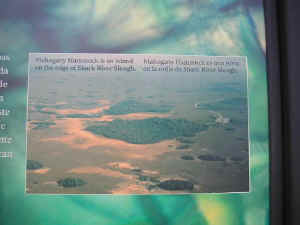
mh02.jpg: View from the air of Mahogany Hammock.
|
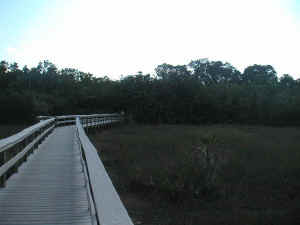
mh03.jpg: View from the boardwalk approaching the trees. The biggest of the mahogany trees can be seen at center right of the photo.
|
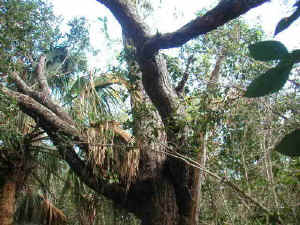
mh04.jpg: One of the dozen or so large mahogany trees left standing. This one was at the edge of the stand and seemed to have a more "open grown" form than the other large trees there.
|

mh05.jpg: Another of the big mahogany trees. Note the many epiphytes or "air plants: growing on the trunk and limbs.
|
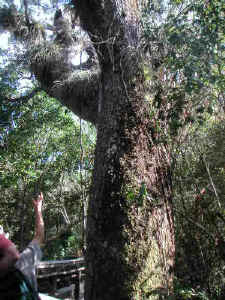
mh06.jpg: The grand old tree. Veteran of perhaps 500 south Florida hurricane seasons.
|
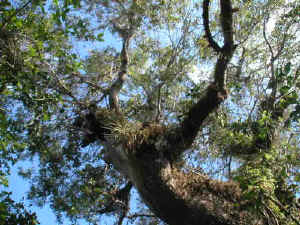
mh07.jpg: The crown of the champion mahogany. Again note the epiphytes attached to the tree.
|
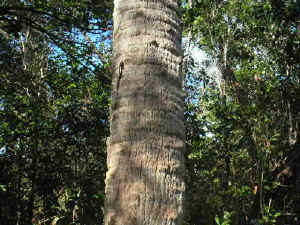
mh08.jpg: A blue-tailed skink on a palm tree.
|
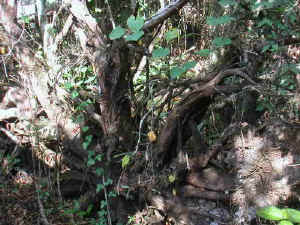
mh09.jpg: One of the dozens of victims of Hurricanes Donna and Andrew. Apparently the root system of these trees was wide but shallow, making them susceptible to strong winds.
|
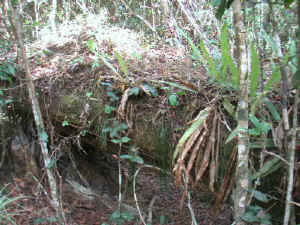
mh10.jpg: The fallen trees have become nurse logs and are covered with even more plants than the standing trees.
|
| RE:
Swietenia mahogani |
Ernie
Ostuno |
| Apr
20, 2005 15:28 PDT |
|